For trail runners taking on sub-ultra races (20–49 km), wet weather and muddy trails are always a risk. Waterproof trail running shoes give you the confidence to run through puddles, storms, and stream crossings—keeping your feet dry, blister-free, and strong for every kilometer. In this expert guide, discover the best waterproof models, learn what technology actually works, and get pro tips for dominating rainy trail races!
Check the full main guide: Best Trail Running Shoes for Sub-Ultra Distances
🌧️ Why Waterproof Trail Shoes Matter for Sub-Ultra Races
Unpredictable weather is the rule, not the exception, on most trail races under 50 km. Even if the sun’s out at the start, rain, mud, and stream crossings can quickly turn the course into a slippery, wet challenge. Wet feet mean blisters, heat loss, and chafing—potentially ending your race early. That’s why waterproof shoes aren’t just for mountain ultras—they’re a secret weapon for every serious sub-ultra runner.
- Dry Feet, Fewer Blisters: Waterproof membranes prevent outside water from soaking your socks, so your skin stays protected mile after mile.
- More Confidence: Run straight through puddles, mud patches, and shallow streams without hesitation or losing momentum.
- Cold Weather Bonus: Waterproof shoes also offer better insulation, reducing the risk of numb, cold toes in winter or high mountain events.
🔬 How Waterproof Trail Shoes Actually Work
Modern waterproof trail shoes use thin, breathable membranes (most commonly GORE-TEX®, eVent®, or proprietary blends) built between the outer fabric and inner lining. These allow sweat vapor out, but block water droplets from getting in. However, not all “waterproof” is created equal!
- GORE-TEX®: The gold standard—tested for durability, breathability, and waterproofing in the harshest conditions.
- eVent®: Competes with GORE-TEX for breathability and fast vapor release; often slightly lighter, but sometimes less durable in long-term mud.
- Proprietary Membranes: Many brands (Salomon, The North Face, Brooks) use their own systems—sometimes just as effective, but read real-world reviews for confirmation.
- Water-Resistant Shoes: These repel splashes, but can’t handle full submersion or heavy rain. True waterproof models are better for real storms.
Key point: No waterproof shoe breathes as well as pure mesh—but in cold, wet races, staying dry is often worth a little extra sweat.
🥾 Top Waterproof Trail Running Shoes for Sub-Ultra Distances (2025)
| Model | Membrane | Weight | Best Use | Pros | Cons |
|---|---|---|---|---|---|
| Salomon Speedcross 6 GTX | GORE-TEX | 320g | Mud, wet grass, mountain | Legendary grip, bombproof water protection | Heavy, narrow fit |
| Hoka Challenger ATR 7 GTX | GORE-TEX | 270g | Mixed, cold/wet | Plush, good for long runs, true to size | So-so grip in deep mud |
| Brooks Cascadia 17 GTX | GORE-TEX | 298g | Technical, rocky, rainy | Stable, roomy toe box, great wet rock grip | Slower to dry if fully soaked |
| La Sportiva Ultra Raptor II GTX | GORE-TEX | 340g | Mountain, aggressive | Tank-like, unbeatable protection, secure fit | Very heavy, less “speedy” feel |
| Inov-8 Roclite G 315 GTX | GORE-TEX | 315g | Mud, fell, mountain | Graphene grip, flexible, versatile | Can run hot on warm days |
| Merrell Moab Speed 2 GTX | GORE-TEX | 305g | Mixed, beginner-friendly | Soft ride, excellent for comfort | Moderate grip in deep mud |
| Adidas Terrex Agravic Flow 2 GTX | GORE-TEX | 285g | Fast, versatile, rain | Speedy, balanced cushion, secure fit | Tighter for wide feet |
| The North Face VECTIV Enduris 3 Futurelight | Futurelight™ | 295g | Mixed, muddy | Soft, flexible, eco-friendly membrane | Less proven than GORE-TEX in long-term |
- Salomon Speedcross 6 GTX: For pure mud and rain, few can compete. Massive grip, maximum protection, but heavy for longer distances or fast runners.
- Hoka Challenger ATR 7 GTX: Comfortable and versatile for both new and experienced trail runners. Well-cushioned, but not a pure mud specialist.
- Brooks Cascadia 17 GTX: A technical all-rounder, stable in wet rocks, reliable GORE-TEX, and excellent for rainy Turkish spring races.
- Adidas Terrex Agravic Flow 2 GTX: Fast, flexible, and works for a wide range of distances and terrain—except for the muddiest events.
💧 Waterproof vs Breathable: Which Should You Pick?
| Feature | Waterproof Shoe | Breathable/Mesh Shoe |
|---|---|---|
| Water Resistance | Excellent (keeps water out) | Poor (absorbs water) |
| Breathability | Moderate | Excellent (dries fast, cools feet) |
| Best For | Rain, mud, cold, snow | Hot weather, dry trails, summer races |
| Weight | Higher (adds 25–50g) | Lighter |
| Fit | Snug (membrane adds thickness) | Flexible, adapts to foot |
| Drying Speed | Slow if fully soaked | Very fast |
- Choose waterproof: Rain forecast, cool weather, routes with multiple streams, muddy or snow events, early spring/fall.
- Choose mesh: Hot, dry weather, races above 25°C, when speed and ventilation are more important than dryness.
Hybrid tip: Some experienced runners rotate—mesh for training, waterproof for race day!
🏆 Training & Racing in Wet Conditions: Pro Tips
- Choose thin, anti-blister synthetic or merino wool socks. Avoid cotton!
- Tape hot spots (heels, toes) before the race starts.
- Use trail gaiters to keep debris out of your shoes.
- Loosen laces slightly if racing in cold/rain to allow for foot swelling.
- After stream crossings, keep moving—your body heat helps dry minor moisture fast.
- Pack a dry pair of socks for the finish line (and for drop bags in longer events).
- Practice on muddy, wet trails during training so your race-day skills are sharp.
🧼 How to Maintain & Extend the Life of Waterproof Shoes
- Rinse mud and debris off with clean water after every wet run.
- Remove insoles and air dry at room temperature (never on a radiator or heater).
- Apply waterproofing spray (approved for membranes) every few months for extra protection.
- Avoid harsh soaps or machine washing, which can damage membranes.
- Stuff shoes with paper towels or newspaper to absorb moisture overnight.
- Rotate with another pair if running consecutive wet days to allow full drying.
Pro tip: Even waterproof shoes eventually get overwhelmed—plan to replace them if the membrane develops leaks or persistent odors.
🚫 Common Mistakes When Choosing Waterproof Trail Shoes
- Buying waterproof shoes for hot, dry climates—feet can overheat, leading to blisters.
- Assuming all waterproof shoes fit the same as regular models—membranes can make them tighter.
- Wearing thick socks “for extra warmth”—thinner is actually better for moisture control.
- Neglecting post-run drying—wet shoes left in a bag can mold or lose their waterproof ability.
- Relying solely on the membrane for water protection—deep water will always get in from the ankle!
🗣️ User Experiences & Real Race Reports
“The Speedcross GTX kept me dry on the wettest day of the Kaçkar Marathon. The grip saved my race, and no blisters even after five hours!”
– Murat, Rize
“Challenger GTX shoes were comfy in the Taurus Mountains, but I switched to mesh after lunch—my feet got hot as the sun came out.”
– Zeynep, Antalya
“After years of ignoring waterproof models, I finally tried Brooks Cascadia GTX for Cappadocia Ultra. Zero blisters and felt super confident jumping streams!”
– Serdar, Nevşehir
❓ Frequently Asked Questions
🌧️ Are all waterproof shoes truly waterproof?
🧦 What socks work best with waterproof shoes?
💨 Do waterproof shoes cause sweaty feet?
🦶 How do waterproof shoes fit compared to regular models?
❄️ Are waterproof shoes warm enough for winter?
👟 Can I use waterproof shoes for road running?
🚰 Do waterproof shoes drain water if fully submerged?
🧼 How do I clean muddy waterproof shoes?
🔄 When should I replace my waterproof trail shoes?
💸 Are waterproof models more expensive?
📦 How should I store waterproof shoes?
🧽 Do waterproof sprays actually help?
🌡️ Are waterproof shoes good in hot weather?
🏔️ Should I buy waterproof shoes for every trail race?
📚 Further Reading
- REI: How to Run Trails in the Rain – Gear, socks, and technique for wet races.
- Switchback Travel: Best Waterproof Trail Running Shoes – Model-by-model comparisons.
- Runner’s World: Best Waterproof Running Shoes
Final Thoughts
Waterproof trail running shoes are your shield against the elements in sub-ultra races. Choose wisely, break them in, and remember—staying dry means staying fast and happy, no matter what the sky throws at you. 🏃♂️🌧️


About the Author
Lost Pace is an ultramarathon runner, shoe-tester and the founder of umit.net. Based year-round in Türkiye’s rugged Kaçkar Mountains, he has logged 10,000 + km of technical trail running and completed multiple 50 K–100 K ultras.
Blending mountain grit with data, Lost analyses power (CP 300 W), HRV and nutrition to craft evidence-backed training plans. He has co-written 260 + long-form guides on footwear science, recovery and endurance nutrition, and is a regular beta-tester of AI-driven coaching tools.
When he isn’t chasing PRs or testing midsoles, you’ll find him sharing peer-reviewed research in plain English to help runners train smarter, stay healthier and finish stronger.
Ultrarunner · Data geek · Vegan athlete

